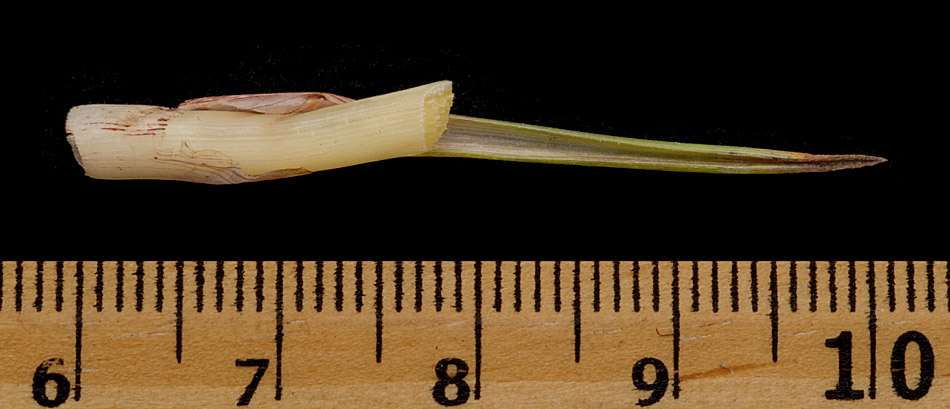 |
Flowers
and achenes naked in the axils of scales, not enclosed in a sac; flowers
usually perfect (sometimes some flowers imperfect in Cyperus,
Rhynchospora and Cladium). NOT [Flowers and achenes enclosed in a
sac (perigynium) borne in the axils of scales; flowers imperfect.] |
 |
Perianth
bristles absent or up to 6 per flower; if more than 6, then only
somewhat longer than the achenes. NOT [Perianth bristles usually
more than 10 per flower, much longer than the achenes, conspicuously
elongated to over 10 mm long in fruit stage and usually obscuring most
scales in spikelets.] |
 |
Inflorescence
not a solitary, terminal spike; if solitary, terminal and spike-like,
then inflorescence +/- terete. NOT [Inflorescence a compressed,
solitary, terminal spike bearing few-flowered spikelets attached in 2
rows.] |
 |
Inflorescence
usually with > 1 spikelet; if only 1 spikelet present, then
inflorescence bract usually 10 - 200 mm long (but as short as 7 mm in
Schoenoplectus subterminalis) and achenes 2 - 3.5 mm long. NOT
[Inflorescence a solitary terminal spikelet; inflorescence bracts absent
or up to 8 mm long and only slightly longer than the spikelet; achenes
usually <= 2 mm long (up to 2.3 mm in Eleocharis quinqueflora).] |
 |
Achenes
lacking a tubercle but sometimes beaked. NOT [Achenes with a
narrowly triangular tubercle.] |
 |
Scales of
spikelets spirally arranged; spikelets terete. NOT [Scales of
spikelets 2-ranked; spikelets flattened or 4-sided.] |
 |
Plants
without the following combination of characteristics. NOT [Culms
tall and slender, 30 - 100 cm high and 1 - 2 mm wide; inflorescences
with stiffly ascending primary and secondary branches supporting 100 -
1,000 spikelets in compact clusters; achenes terete with bases discoid,
truncate, impressed and flared.] |
 |
Inflorescences
not subtended by leaf-like bracts, the proximal bract terete, trigonous
or thickly C-shaped in cross-section and resembling a continuation of
the culm (making the inflorescence appear to be attached to the side of
the culm although the bract may be pushed aside in Amphiscirpus as the
spikelets mature); longest bracts exceeding the inflorescence or not;
usually all leaves basal with blades often much shorter than their
sheaths. NOT [Inflorescences subtended by 2 or more leaf-like,
erect to spreading bracts; longest bracts exceeding the inflorescence;
leaves basal and cauline, or all cauline with cauline leaf blades well
developed.] |
 |
Achenes
beaked; scales shiny or dull, various shades of brown without strongly
contrasting midribs; ligules membranous, lacking hairs; culms and leaves
+/- spongy due to presence of air cavities; proximal sheaths not
disintegrating into fibers. NOT [Achenes beakless; scales often
glossy (as if lacquered), chestnut-brown with contrasting pale midribs;
ligules ciliate usually with some hairs visible along the sheath summit
where it joins the blade; culms and leaves wiry and tough, air cavities
lacking; proximal sheaths often disintegrating into fibers.]
|

